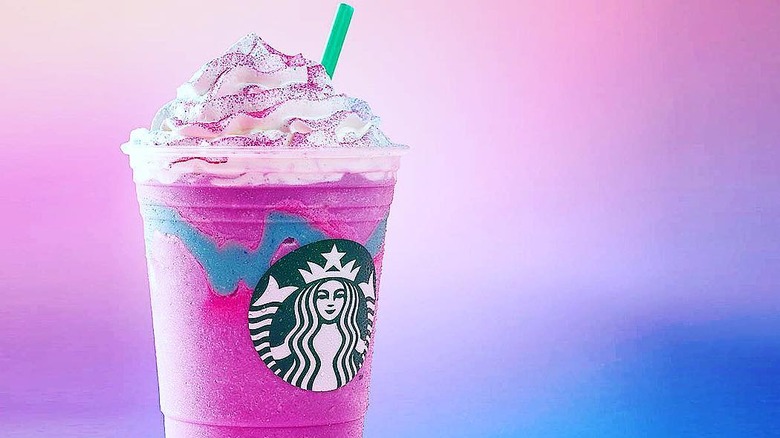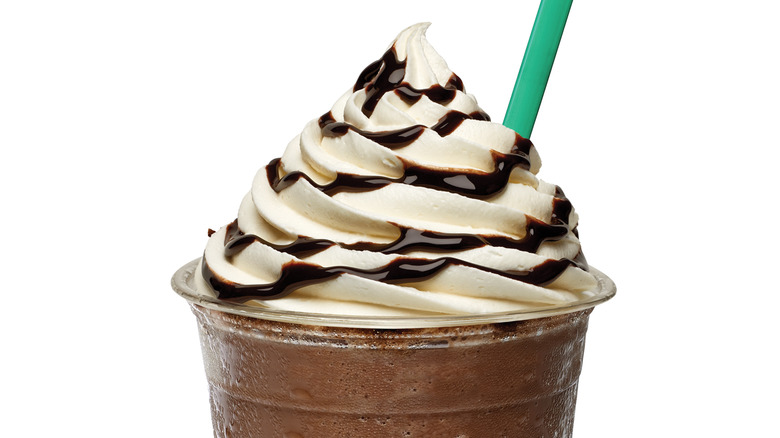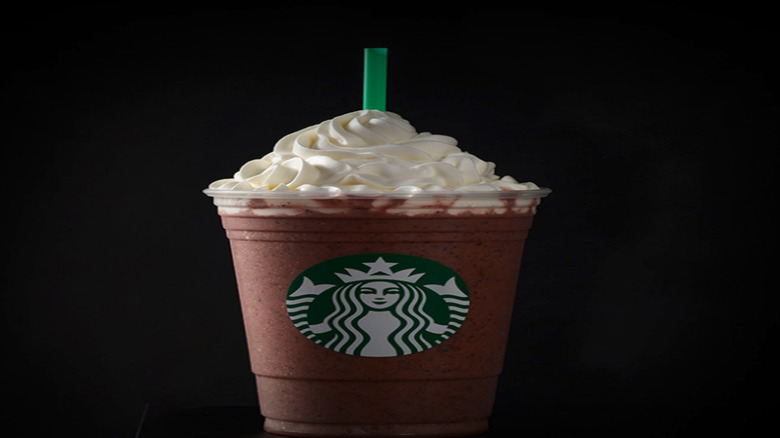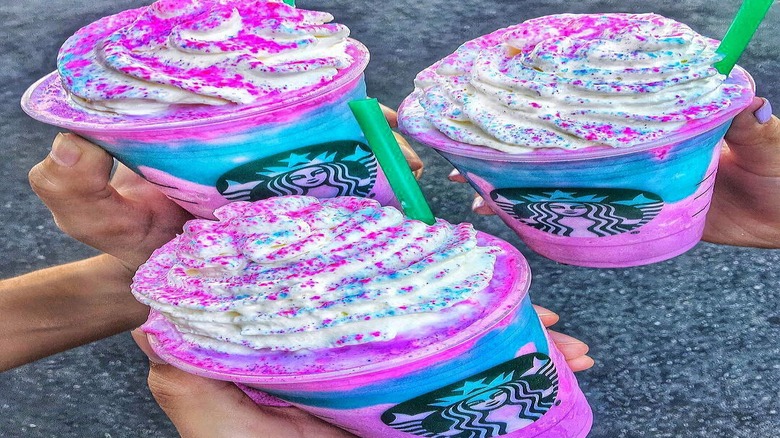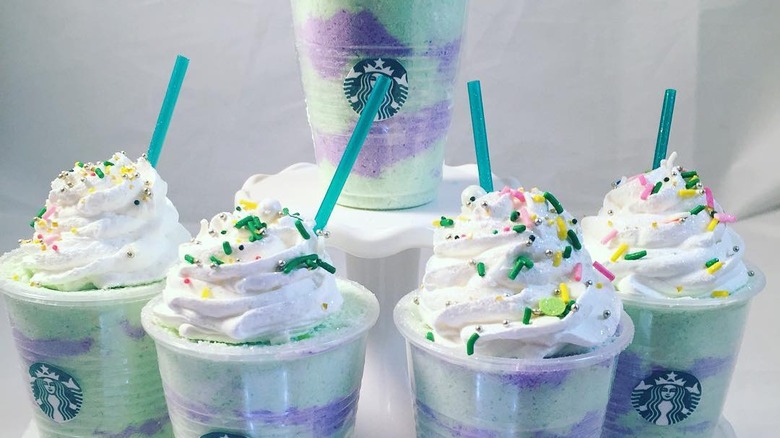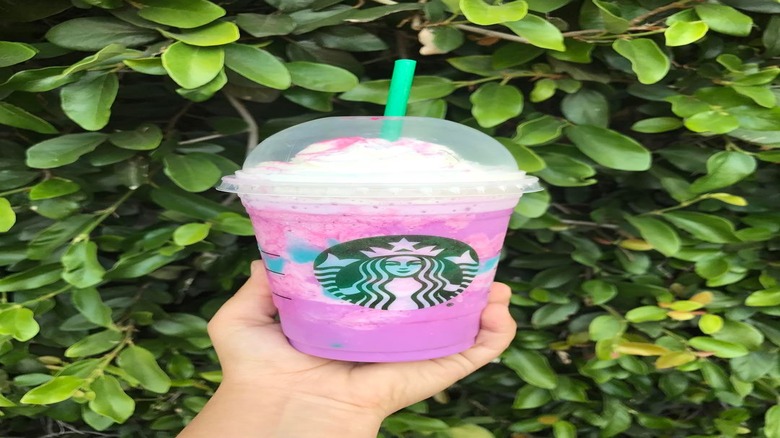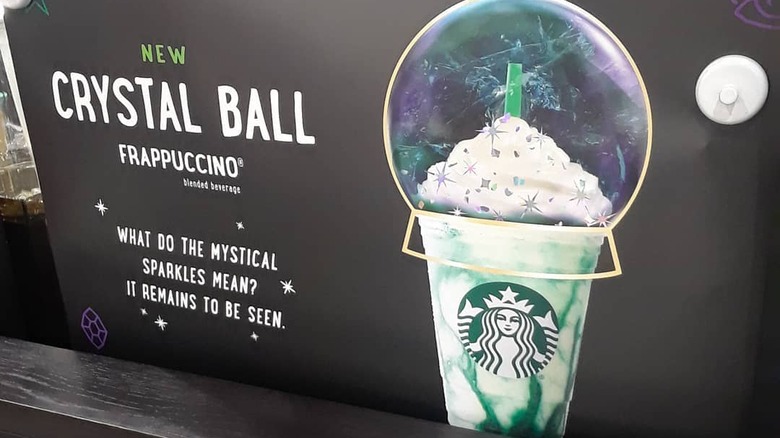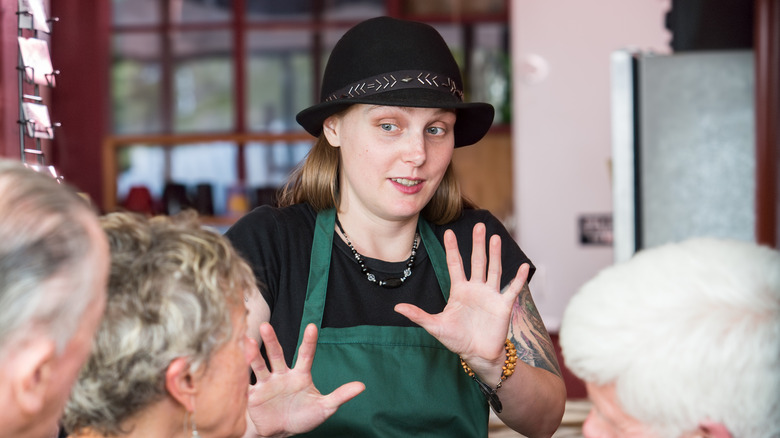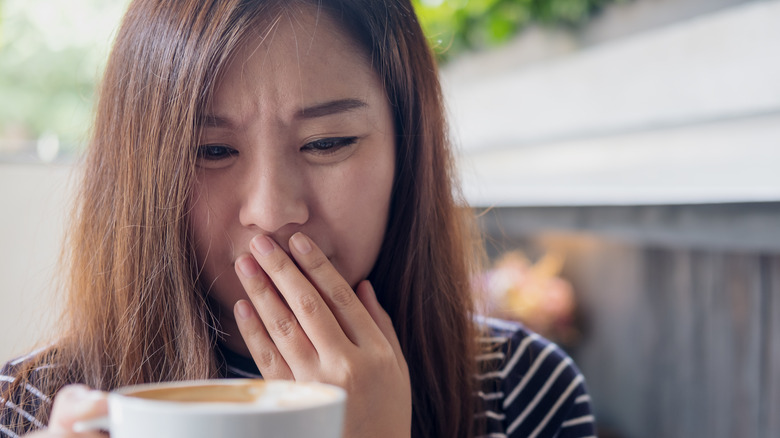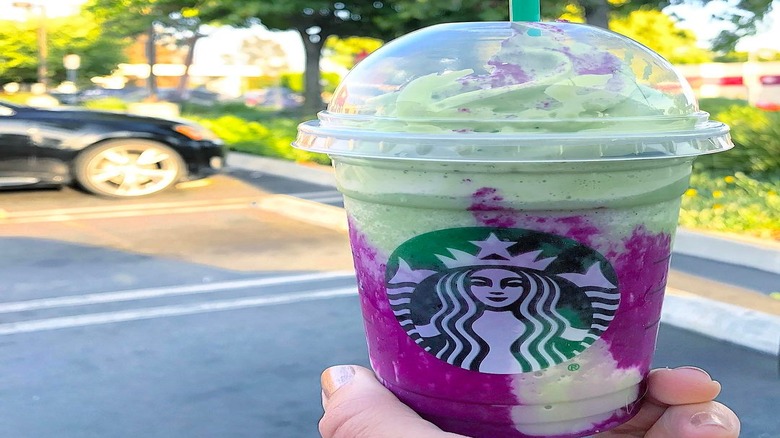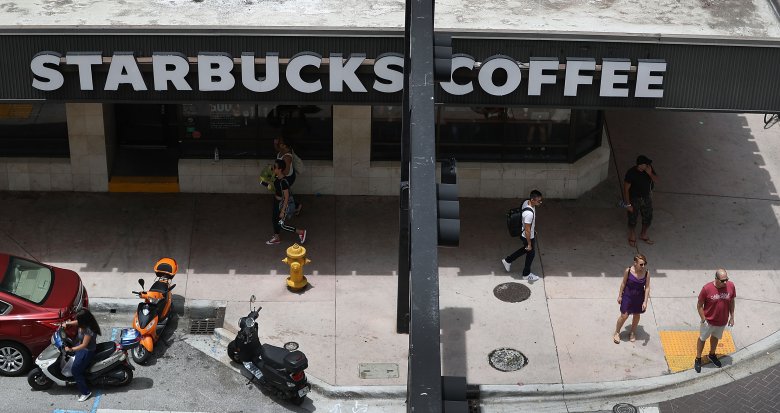The Untold Truth Of Starbucks' Limited Edition Frappuccinos
Starbucks stumbled upon a massive hit when they released the Unicorn Frappuccino in April 2017. Little did they know it would become a viral hit with people scrambling all over their respective areas trying to locate the mythical creation. Some people even tried to make their own with questionable results. Regardless, the Unicorn Frappuccino put the special edition fraps on the radar of everyone within two miles of a Starbucks — which is practically three quarters of the planet.
Starbucks parlayed the Unicorn into more special edition frappuccinos in 2017, and in 2018 rolled out the most recent — the Crystal Ball Frappuccino. But if you're new to the frap party and only know about the Unicorn Frappuccino and everything that came after, you're in for a shock; Starbucks has been down this road before, and this road is always pretty short. The Unicorn wasn't the first limited edition frappuccino by a long shot, it was just the first one to make major waves. So what's the deal with all the special frappuccinos? Are they worth the hype and the hassle? Is it too much... Um... frap... to deal with?
What is a frappuccino?
Let's start with the basics: A frappuccino just a milkshake. Really. You're probably having one of two reactions. "Um... my milkshakes don't have ice in them." Or "Yes, I am from New England." A milkshake is actually defined as milk and ice cream whipped until foamy. But in New England that very thing is called a "frappe" (pronounced "frap").
So in New England, a frappe has ice cream, but as you well know, a Starbucks frappuccino doesn't have ice cream, just milk and ice — which in New England would be called a milkshake. Confused yet? Don't worry, so are we. The moral of the story is New England isn't very good at naming things and Starbucks took the word "frappe," made it sound a little more Italian, and in 1993 tested the frappuccino. It went over very well, and by 1995 the frappuccino went to every Starbucks store. And those poor New Englanders were stuck screaming "That's not a frappe!"
Before the Unicorn
Generally speaking, should you want to order a frappuccino you could look over the menu for a while; the standard frappuccino menu is rather expansive. But that didn't mean there wasn't room for a few more "special" frappuccinos. If your introduction to the the unique frap came with the Unicorn, you'll be surprised to know they have a vast history of "limited" edition frappuccinos. In 2002, Starbucks offered up a Mocha Coconut Frappuccino (which returned briefly in 2011 for a... you guessed it, limited time), as well as many seasonally-themed, short-lived offerings. The first ones to really make a splash were in 2015. Starbucks rolled out six limited edition flavors — including Red Velvet Cake Creme, and in 2016 a Cherry Blossom Frappuccino — usually only available in Japan — for a limited time. A few survived and remain available, like the Red Velvet Frappuccino. Most of the others went extinct and didn't have nary a blip on the national radar. But then again, none of those had the magical powers of the Unicorn.
Behold... the Unicorn!
Even if you've never stepped foot in a Starbucks and are one of those Diet Coke instead of coffee people, you've heard of the Unicorn Frappuccino. Introduced on April 19, 2017, the limited edition drink — for a lousy four days — promised a color change and a flavor change; from blue to pink and tangy to tart. And the world erupted over the Unicorn Frappuccino, as it was suddenly everywhere! That tiny four day run (which saw many locations run out of supplies way before the fourth day), got people buying not just the Unicorn but all sorts of Starbucks drinks. Sales skyrocketed, up four percent in same-store sales from 2016 to 2017 for that month. And not one to look a gift... um... Unicorn in the mouth, Starbucks slyly announced that they had "A lot more coming." And every Starbucks fan and Instagram enthusiast rejoiced!
Not every frap had the power of the Unicorn
Still riding high from the success of the Unicorn Frappuccino, Starbucks began serving the Dragon Frappuccino that same month. Following the Dragon was a Mermaid Frappuccino in August of 2017 — obviously there's a mythical creature theme here. The problem was, no one really slayed the Dragon, and the Mermaid kinda sank; the viral hype didn't even come close to the Unicorn. Still, Starbucks didn't give up on trying to find their next viral concoction. Next came the Zombie Frappuccino (obviously in celebration of Halloween), and then around Christmas came the Christmas Tree Frappuccino, which they tried their hardest to make look like a Christmas tree in a cup.
If you've never heard of the last two, that's not surprising. After the tremendous buzz of the Unicorn, the world of what's viral went back to kids ruining live shots and a dancing backpack dude. Starbucks roared — three more times — but no one listened.
Why did the Unicorn hit?
What was the big difference between the Unicorn, its predecessors, and all the animals, walking dead, and Douglas Firs that followed? The executives at Starbucks called the Unicorn Frappuccino "Instagrammable," meaning that regardless of which filter you threw up, that Unicorn Frappuccino sure took a pretty picture. Hold a Unicorn Frappuccino up in front of some Ivy? At least 50 likes, guaranteed. They're certainly not wrong. Starbucks realized pretty early on that they had something special going on, and hoped that the viral buzz would carry over to a Happy Hour promotion in May of 2017.
Rarely, however, does internet buzz sell things. The internet basically released Snakes On A Plane, and then didn't go see it. And despite all the social media free publicity Starbucks could possibly get, the Happy Hour didn't get a happy ending; after a lackluster 2017 Happy Hour they announced there would be no 2018 Happy Hour promotion.
Is the craze gone?
Sometimes you capture lightning in a bottle, and all the zombies, mermaids, dragons, and Christmas trees can't do anything about it. Starbucks customers did realize that the limited edition items are simply a gimmick to get customers in the store. There's nothing wrong with that, but the problem is that the following gimmicks didn't increase foot traffic.
But still, being a "limited edition" whatever wasn't enough to get people in the door. The fanfare for the Crystal Ball Frappuccino arrived with a thud on March 23, 2018. The barista at the store I visited one hour before closing time told me that I purchased the tenth Crystal Ball Frappuccino of the day — for the Unicorn they had sold their supply out in the early afternoon on day one. In 2018, the general public reaction to Starbucks' limited edition frappuccinos seems to be a resounding "meh..."
Baristas don't really like making them
Ordering at Starbucks is either a fine art or the most painful thing this side of invasive exploratory surgery. Everyone has their little quirks to ordering, and certain things do take a little more time. Almost universally, baristas hate making "limited edition" drinks. As one barista tweeted during the Unicorn Frappuccino craze, "As a barista, just know that every time you ask me to make this, a part of me dies." A barista told me that making the Crystal Ball is actually more of a pain than the Unicorn, due to the extra swirl. Regardless, knowing that making one of these limited time drinks slays the soul of your barista and takes a long time to make (as if the other stuff doesn't) doesn't make ordering one a ton of fun — and the last person anyone wants to anger is their favorite barista. If you ordered up a special "limited edition" drink and the barista faked a smile, now you know why. There are a lot of dumb ways to order at Starbucks, but when one of them is offered up by corporate, that doesn't help the cause.
Is the big problem taste?
Taste is subjective, but a lot of people didn't like the overly-sweet Unicorn Frappuccino. Some loved it, for sure, but it's safe to say that Starbucks rode the Unicorn to a financial victory via social media, not return sales. After all, the hype reached such stratospheric levels that a lot of stores ran out of supplies way before the fourth day of sales. The other 2017 frappuccinos didn't get the chance to run out of supplies — mainly because no one came back to have another after that initial Dragon or Mermaid. The Christmas Tree tasted like "broken promises and Thin Mints," according to one writer. A knowledgeable foodie agreed, telling me it was "nasty." The year 2018 saw the Crystal Ball, which generally speaking aren't edible. It's not bad, and some even liked it — one taster told me, "Oh, I like this... PEACH! Oh, didn't see that coming." But not a lot of people count on "not bad" as a winning formula. Gimmicky flavors only work when they taste good, and don't rely on hip names and social media buzz — especially when that social media buzz is non-existent.
You can still get some if you want
If you really did enjoy a few of the "limited edition" frappuccinos, there is still a way to get one with relative ease. Having a secret menu isn't very secretive nowadays — in fact it's pretty much the norm. Some restaurant secret menus are just that, and sometimes ordering certain items is simply impossible. Then there's Starbucks; they hold secrecy as tightly as a password that is "password." Everything in the Dragon and Mermaid Frappuccinos are readily available on the regular menu; all it takes is the secret password. You just have to say, "I'll take a Dragon/Mermaid Frappuccino" and the barista will happily (not happily) whip one up for you. There's a slight chance you might have to tell them exactly what's in it, but that's the price you have to pay to get what you want. A few of the limited time frappuccinos made the regular menu, so there's always still a chance that "limited" doesn't really mean limited.
What does all this mean for Starbucks?
Without a Unicorn Frappuccino type hit in December, sales didn't meet expectations for the final quarter of 2017. All the hype, free publicity, and foot traffic didn't amount to a hill of (coffee) beans as same-store sales only rose two percent for the year — and given the odds (and the 2018 start to the limited edition menu) Starbucks' outlook is magically rolling to "hazy, ask again." The year 2018 also saw the closing of Teavana, a mall-based chain owned by Starbucks. These days, 29 percent of coffee drinkers have a single brew system (think Keurig or Ninja) at home, which isn't going to get people off their couches and down to the Starbucks. Stock experts say not to worry, but the long-term answer clearly isn't limited edition frappuccinos. The Unicorn Frappuccino was a lot of fun, but the reality is that the limited edition frappuccinos are just that — fun. Maybe one day there will be another Unicorn hit for Starbucks, but that isn't what the chain is all about. Coffee is. Lots and lots of coffee.
